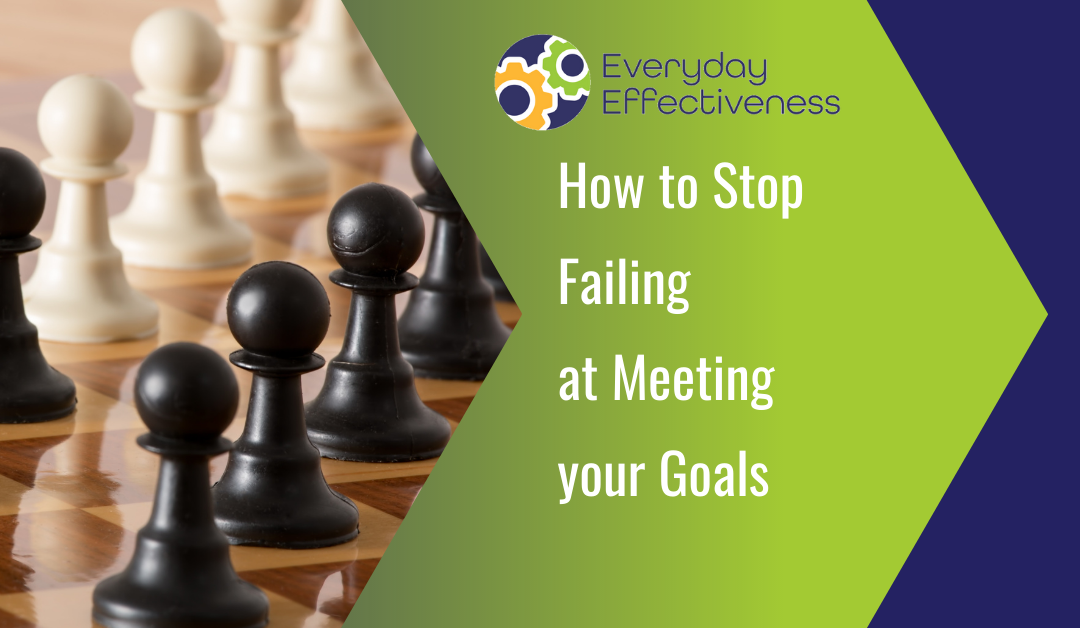
by Gwen Bortner | Office Productivity, Tasks & Goals, Tips & Tricks
Setting goals is great – it feels so good to think about the future and make plans for the greatness you will achieve in the coming year. The hard part comes when you start looking back at the goals you set, and you realize you haven’t met any of them. Stop letting yourself down – learn how to actually MEET the goals you set so that you don’t have to feel like a failure any more!
Here are my best tips for achieving the goals you set for yourself, whether they’re for life or business or both!
Tip #1: Understand whether or not this goal REALLY matters to you.
Often when we fail to reach a goal, it’s because we gave them lip service but weren’t truly inspired to reach them. We thought we should set the goal but as it turns out, we don’t want to actually work with it. So the first step is to eliminate all the goals that don’t actually matter. Though this may *feel* a bit like failing at those goals, in reality it’s more like de-cluttering your goal list so you can focus on working towards the things that matter most.
Tip #2: Keep your goal count low.
When you set too many goals at once, you’re focusing on too many things and you don’t get any progress made. Even if you have several goals in mind, choose just a few to focus on at any one time so that you can make real progress. It’s better to check off your goals one at a time because you can use that progress to motivate you to work toward the next goal, rather than pushing yourself to work on too many projects at once and feeling like you’re never going to finish anything.
Tip #3: Partner with someone who has similar goals.
This type of relationship is called an accountability partner, and it can be really helpful to work together with someone who has similar goals to your own. The concept is most familiar in the form of a workout buddy but it can be applied to any goal. The key is to work toward supporting one another and not turn it into a competition.
Tip #4: Work with someone who can help to push you toward reaching your goal.
Instead of an accountability partner (someone who has a similar goal), this tip is more about finding an outside person to motivate you to work on your goal. It might be a partner or friend or it could be someone like a business consultant or coach.
Tip #5: Set 3-Level Goals.
Todd Herman suggests you should give yourself goals at 3 levels: good, better, best. For instance: the best-case scenario is that you want to lose 50 pounds, but good would be 10 and better is 25. If you ONLY set the highest-level goal then it often takes too long to reach it and it’s easy to get discouraged. But when you reach the good or better goal then that can even be what motivates you to push to the next level.
Tip #6: Look for the WOW Mindset.
Instead of looking at how far you have to go, you look at how far you have already come. Instead of, “I’ve still got 9lbs to lose,” think of it like, “WOW, I lost a pound already!” Looking at your goals from the mindset of the progress you’ve made rather than what’s left to do is a way to encourage yourself to keep making that progress. (This is another of Todd Herman’s great ideas!)
Tip #7: Avoid the OW Mindset.
Herman’s final contribution to this post is the “OW Mindset,” or the idea that all too often we focus on what’s left to come instead of on how far we have already climbed. This tip is the companion to the last one; avoid thinking of the “pain” of what’s to come and instead focus on the success of what you’ve already achieved.
Tip #8: Recommit to your goals on a regular basis.
Review your progress, make adjustments as needed, and keep moving forward. This is the foundation of making actual progress – the process of checking up on the progress you’ve made and reminding yourself why you wanted to achieve that goal in the first place.
Sometimes, reaching the truly important goals requires more motivation and resources than you can drum up all by yourself.
If you’d like some help reaching your goals for 2022, I’m offering a free workshop where I’ll be teaching my 3 best strategies for reducing overwhelm and meeting your goals. Click here to sign up!

by Gwen Bortner | Leadership, Tips & Tricks
In my last post, I outlined the biggest obstacles we face when we have to make a tough decision (click here if you haven’t read that one yet). This is also a follow-up to the piece I wrote for APeeling Magazine; if you’d like to read the original piece, click here.
Knowing what’s holding you back from making a big decision is half the battle – but it’s only the first half. It helps to give you clarity and insight, and to move past any emotional or tangible roadblocks you may be facing. Now that you know what’s holding you back, your next task is to actually make the decision, and that’s where it can be tricky.
Today, I’m sharing my top strategies for making decisions when there isn’t a clearly “right” answer. I have used these strategies to set business goals, make decisions that would move my company forward, and even to make challenging personal decisions. Maybe one of these strategies will help you in a similar situation – make sure to bookmark this page so you can come back to it when you’ve got to make a big decision.
Strategies to Help You Make Better Decisions
The Stair-Step Method
This one is for a decision where there are multiple options, and you’re not sure how to choose between so many possibilities. For this strategy, make a list of your options and number them in order. The trick is, instead of trying to look at every possibility all together, you’re going to narrow it down one pair at a time. Look only at choice #1 and choice #2. Pick the best option JUST between those two. Now, put the winner of that contest up against choice #3, and pick the best option only between those two. Repeat this process until you reach the bottom of your list. The winner of the final 1-on-1 contest is the choice you’re going to pick. (Note: you don’t go back through the list and pair them up differently a second time; you get to the bottom and that’s it. Like a sports bracket, there’s one clear winner, and the match-ups don’t get shuffled around after the final game.)
Beyond the Pros and Cons
Chances are, if you’ve been stuck on a decision for any length of time, you’ve probably already tried making a pro/con list, and you still don’t have enough clarity to make the decision. If you’re trying to make a “yes or no” decision, try this strategy instead, which is a twist on the classic pro vs. con list. Divide your paper into four sections and label them like so: pro/want, pro/need, con/want, and con/need. Now, you still brainstorm a list of pros and cons, but you associate each one with something you want or something you need. This can be especially helpful if you’re making a decision that involves doing something difficult that you don’t really want to do, but you know it will move you forward. Breaking the pros and cons up into four different categories can give you clarity on the strongest options between them, and can also help you see if you’re holding yourself back from a decision because it isn’t really what you want to do.
Short vs. Long Term
Use this strategy when you’re choosing between two options that have a lot in common. The similarity between them is likely what’s holding you back from picking one in the first place, so this strategy can really help with that. For each option, make a list of short-term wins and long-term wins if you were to choose that option. When you compare them side-by-side, it can be easier to see the overall benefit of each choice. Do you really need a short-term win in order to get over an immediate hurdle, or will your business benefit overall if you play the long game and wait for a win that takes more time? As you’re evaluating the options, ask yourself: will you be glad you made this choice in 3 months, 6 months, a year? The phrase I use is: Will Tomorrow Me thank Today Me for this decision? This can help you really weigh the options and make the best choice.
If you’re still struggling, you may be putting far too much emphasis on one single decision. In almost every situation, you will have an opportunity to choose differently at some point in the future. There will likely be a cost – of time, money, or opportunity – but there will be a time when you can reverse a decision or take a different path. It’s very rare that a decision is both life-changing AND permanent, but sometimes it can feel that way in the moment.
If you struggle with making decisions, adding these strategies to your toolkit should help you make confident choices to move your business forward. If you still need some help, sometimes the best thing you can do is bring in an outside perspective; someone else who isn’t emotionally attached to the outcome of your decision can bring clarity to the situation that you may not be able to find on your own. If you’d like some help with your decision-making, click here to book a 1-on-1 coaching session with me. Let’s tackle this problem together!

by Gwen Bortner | Leadership, Marketing, Operations
Recently I wrote an article for APeeling Magazine about how to get out of your head when you’re faced with an important decision. Today I’m sharing some similar ideas, but if you’d like to read the original article, click here.
I’ll bet if I asked you to track all the decisions you make in any given week, the number would easily be in the double digits. And that isn’t counting all simple, mundane decisions we make every day. As the CEO of a company, some of the decisions you make are small and simple – there’s an obviously right choice, and it only takes a few minutes of your time. However, there are also those other decisions, the ones that carry more weight or don’t have an obviously right answer, that tend to suck away all of your time and energy for longer than you’d like. If you’ve ever been lost in the weeds of making an important decision, today’s post is for you.
Chances are your decision-making struggle is caused by one or more of the following scenarios:
Outside Pressure
In this situation, you’re struggling to make a decision based on what other people think you should be doing, or your perception of what others will think. If there’s outside pressure pushing you in a certain direction, but your inner voice is telling you that’s not the right solution, it causes conflict. How much easier would life be if we could reject the idea of outside pressure, and just make decisions based on trusting our gut or knowing what we want? Unfortunately, most of us do struggle to meet outside expectations, so this can be a very real problem.
Want vs. Should
You may be struggling because there’s something you know you should do, but you really don’t want to do it. Or vice versa – there’s something you want to do, but it feels like something you shouldn’t be spending your time on. This might be a “suck it up” moment where you really just have to bite the bullet and do the unpleasant thing, even if it isn’t fun or exciting.
Feelings vs. Facts
In this scenario, chances are you know what you need to do, but you’re afraid of hurting someone else’s feelings by making this choice. A similar situation is one where you don’t want to have to inconvenience anyone else to make this decision possible, so you’re afraid to ask them for help. It might help to think about what you’re losing by not making this choice, or what you would lose if you didn’t ask for the help. It can help to have data to help you make the choice that will involve a difficult conversation.
Equal Footing
Sometimes a decision is really hard because it’s either a decision between two good choices or between two bad choices. If you can only choose one thing out of two great options, it can be hard to pick one because you’ve got a fear of missing out on the other option. Conversely, if you’re stuck between a rock and a hard place, neither option feels very appealing. In this case, you probably have to go with what feels the most right (or the least wrong), and just move on.
Alignment with Your Goals
Maybe what’s holding you back from making a decision is that somewhere, your gut is telling you that this decision isn’t really in line with what you need to be working on right now. If you’ve been following a system of setting goals in your business, is this decision going to bring you closer to your current goal, or distract you from it? If you’ve been feeling reluctant but you aren’t sure why, check in with yourself and your goals to see if this decision is truly in alignment with where you should be focusing right now.
Usually, the things that hold you back from making a quick decision are somewhat intertwined. Chances are, you’re actually dealing with more than one of these scenarios at once. The biggest obstacle is identifying what holds you back; once you can do that, it becomes a lot easier to find a solution and move forward.
The next time you’re stuck in the middle of a choice that’s too difficult for you, try identifying what’s holding you back and acknowledging the problem first. Then, make a list of your options so that you can evaluate them and pick the one that’s best for you. As the CEO of your company, you have to hold yourself accountable to making the best decisions that you can, given the tools and resources at your disposal. It isn’t always easy or fun, but it’s necessary if you want to keep moving forward in your business.
If you need some help identifying the greatest area of need in your business, the GEARS assessment can help! Click here to take this free assessment to determine the strengths and weaknesses in your business, so that you can choose the best options to focus your time and energy on for the upcoming quarter.

by Gwen Bortner | Tips & Tricks
When I started teaching, one of my goals was to provide excellent handouts for each class I taught. Years later, based on feedback from my students, it appears that I have met that goal.
[featured-image single-newwindow=”false” id=”130928-Shortcut” alt=”Short Cut the Path”]Photo Credit: mag3737 via Compfight cc[/featured-image]
Creating excellent handouts can be very time-consuming, and even now I still typically invest several days’ worth of time into creating a handout for the first time. But over the years I have developed several shortcuts that have significantly reduced that time investment, and today I will share them with you.
(more…)

by Gwen Bortner | Tips & Tricks
Depending upon your personality, being labeled as “leader” can have either very good or very bad connotations. Some of us find ourselves in leadership positions without much effort or trepidation while others try and avoid the role like the plague. Regardless, I believe everyone is called to lead from time to time – and everyone can be a leader. If you’ve been asked to volunteer for a leadership position, it can be helpful to remember the ways you have been a leader in the past. Don’t think you’ve got any? Let me start with some common examples not often tied to the word “leadership.”
(more…)






